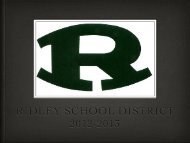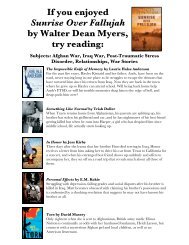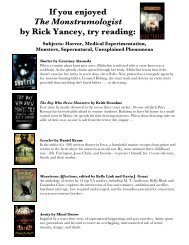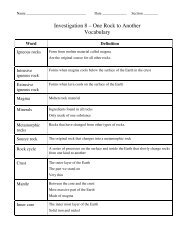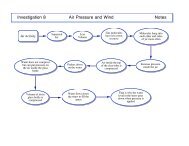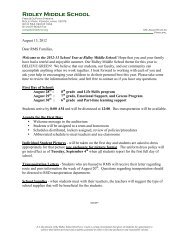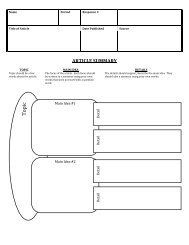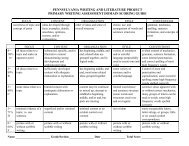Ridley Research Guide - Ridley School District
Ridley Research Guide - Ridley School District
Ridley Research Guide - Ridley School District
You also want an ePaper? Increase the reach of your titles
YUMPU automatically turns print PDFs into web optimized ePapers that Google loves.
Official <strong>Guide</strong> to<strong>Research</strong> at<strong>Ridley</strong> High <strong>School</strong>Contents:Introduction / Basics 1Writing About <strong>Research</strong> 2Plagiarism 5Internal Citations 6Quotations 7Works Cited 7Books & Reference Materials 8Periodicals 11Web Sites 12POWER Library Databases 13Additional Sources 14Subscription Databases 15Missing Information 16Sample Works Cited Page 17<strong>Ridley</strong> <strong>School</strong> <strong>District</strong>Folsom, PennsylvaniaRevised 2011
Official <strong>Guide</strong> to <strong>Research</strong> 1IntroductionIn almost every class in <strong>Ridley</strong> High <strong>School</strong>, you will be asked to turn in written work. Insome classes you will be required to turn in long reports and essays. This guide presents anoverview of some important topics in written communication that should provide the backgroundnecessary for the successful completion of those papers.BasicsAll essays and reports should be typed on white 8-1/2 by 11-inch paper. The type sizeshould be no greater than 12 point, and the font should be easy to read, such as Helvetica orTimes. There should be a one-inch margin on all sides of the paper.A research paper does not need a title page. Instead, beginning one inch from the top ofthe first page and flush with the left margin, type your name, your teacher’s name, the coursename, and the date on separate lines, double spacing between the lines. Double space again andcenter the title. Double space again between the title and the first line of the text.Your last name and the page number should appear in the upper right-hand corner of thepage, within the header. Double-click in the header to access it. Word’s Formatting Palette /Toolbox contains a Header and Footer menu, which includes an “Insert Page Number” icon thatwill automatically number each page of your paper.Written work should be double spaced, unless you are told to do otherwise. Double spacethe entire research paper, including quotes and the list of works cited. Do not try to pad yourwork by increasing the space between lines beyond double spacing.Leave only one space after concluding punctuation marks (period, question mark, orexclamation point) and internal punctuation marks (colon, comma, or semicolon).Never use a cursive or script typeface for a report. Reserve the use of italics for thosespecific times when they are called for such as the title of a book.This guide presents the style rules of the Modern Language Association (MLA), one ofseveral styles that are commonly used by colleges. You will be expected to follow MLA style inmost written work at <strong>Ridley</strong> High <strong>School</strong>. In college, however, you may be asked to cite materialusing the APA (American Psychological Association) format. A sample citation in APA formatfollows; for more information on APA visit www.APAstyle.org.Dorris, M. (1989). The broken cord: a family’s ongoing struggle with fetal alcohol syndrome.New York: HarperCollins.
Official <strong>Guide</strong> to <strong>Research</strong> 2Writing About <strong>Research</strong>Throughout your time in high school, you will be asked to research topics in manysubjects that you study. You will also be asked to report on what you have learned as a result ofthat research. It is very important that in the reporting of the results of research that you indicateclearly where you located the information in your report. The purpose of research is to find outwhat authorities on a subject have discovered or thought.Getting StartedThere are two kinds of research projects common in high school. The first is the mostcommon and the simplest. In this kind of research, you are asked to report on a summary ofinformation about a subject. For example, you may be asked to report on the life cycle of aninsect, the history of women in the military, or school life in France. You are not being asked todefend a point of view but merely to examine materials available on the subject and present asummary of relevant information.A more challenging kind of research requires that you take a stand on a subject. Thisstand will appear as your thesis, or what you are trying to prove. For example, you may besetting out to prove that the telephone was a more important invention than the light bulb, thatthe giraffe has survived because it can forage on vegetation that other animals cannot reach, orthat Robert Frost’s and Emily Dickinson’s poetry share common themes.Doing <strong>Research</strong>There are many potential sources of information. Some projects can be completed frompersonal interviews; others require extensive library research. As you are doing your research, itis important that you keep accurate notes of the sources of the information that you havediscovered and may wish to use in your project. Many teachers require that this information bekept on 3x5 index cards. If your research is from written materials, you must write down all ofthe information that will be required in the listing of the works cited. This information usuallyincludes author’s name, title, publisher, place of publication and page numbers. If you are indoubt as to what information you need, look in the “Works Cited” section of this <strong>Guide</strong> to seewhat you will be required to provide.Whatever kind of report you are creating, whether it is an oral presentation, a slide show,a poster, or a formal essay, it is essential that you let your audience know the sources of theinformation and images that you have used.Since you are a student and not an authority, it is especially important that you give creditto the authorities for the work that they have done.
Official <strong>Guide</strong> to <strong>Research</strong> 31. Widely accepted factsIf you find the same information presented in several sources by several different authors,it is likely that this information is widely accepted as true. It is a fact that the cheetah is a fastanimal. It is a fact that Elie Wiesel wrote Night as a result of his experiences during the SecondWorld War. You do not have to acknowledge the sources of such widely known facts as these.2. StatisticsAlthough any statistics appear to be accepted facts, most can be disputed. For example,one source may say that the average family income is $36,100, and another may say it is$37,200. Which is correct? Since you do not have the means to tell, it is essential that you reportthe source of all statistics.3. Information presented as true but not widely known to be trueA source may tell you that he has discovered that all humans have descended from acommon dog-like creature. While he may assert that the information is true, since he is the onlysource of this information, you must identify the source of the information in your report.4. OpinionsYou must give the source of all opinions used in your report. Generally an opinion differsfrom a widely accepted fact in that an opinion can be disputed. Other people may, quitereasonably, believe differently.Documenting Your <strong>Research</strong>All research for all classes should be documented — that is, you should include with yourreport a complete listing of all of the sources of information used in the preparation of yourreport. If you are doing a formal written report, you should include references to your sourceswithin the body of your report and place a list of the works used at the end. The examples thatfollow show the style that you should use for written research. The rules are rules, notsuggestions.
Josephson 1Laura N. JosephsonMrs. GawbillEnglish 118 Nov. 2011Ellington’s Adventure in Music and GeographyIn studying the influence of Latin American, African, and Asian music on moderncomposers, music historians tend to discuss such figures as Aaron Copland, George Gershwin,and John Cage (Brindle 104). They usually overlook Duke Ellington, whom Gunther Schullerrightly calls “one of America’s great composers” (318). Still little known are the many ambitiousorchestral suites Ellington composed which explore his impressions of the people, places, andmusic of other countries.Not all music critics, however, have ignored Ellington’s excursions into longer musicalforms. In the 1950s, for example, while Ellington was still alive, Raymond Horrics comparedhim with Ravel, Delius, and Debussy:The continually inquiring mind of Ellington ... has sought to extendsteadily the imaginative boundaries of the musical boundaries of themusical form on which it subsists. Ellington since the mid-1930s has beenengaged upon extending both the imagery and the formal construction ofwritten jazz. (122–123)Ellington’s earliest attempts to move beyond the three-minute limit have made hiscreative talents truly outstanding. He has a style and form in the jazz genre that not only hasheightened the awareness of his peers to his musical genius, but also has been shared across thecontinents.
Official <strong>Guide</strong> to <strong>Research</strong> 5PlagiarismPlagiarism is stealing someone’s intellectual work. Once material has been printed, it isgenerally acceptable to quote. There are some guidelines that need to be followed. Generally youmust not quote a passage so lengthy that you are really republishing a work, even if youacknowledge the author. What most plagiarism involves, however, is shorter passages takenfrom a longer work.There are two ways of presenting the work of another writer in your paper. The first ofthese is to paraphrase. The second is to quote directly (see page 7). To paraphrase is to take anauthor’s idea and restate it in your own words. You must follow the paraphrase with an internalcitation. The following are examples to guide you in your writing.OriginalThe work of Fitzgerald must be seen in relation to the strong and sad passion he felt forhis troubled wife, Zelda. She was both an idol and a burden to the maturing writer.From page 234 of James Miller’s The Gatsby ConnectionAcceptable paraphraseMiller notes that Fitzgerald’s writing was influenced by his strong feelings for his wife,Zelda (234).Plagiarized paraphraseThe following is a paraphrase that would be considered plagiarism. It is plagiarismbecause the writer takes the original words and ideas and does not credit them in any way toJames Miller:The work of Fitzgerald must be seen in relation to the passion he felt for his wife, Zelda.She was a burden to him.Acceptable quotationThe following would not be considered plagiarism because it does indicate which wordsare James Miller’s.James Miller points out that “Fitzgerald must be seen in relation to the strong and sadpassion” that he had for Zelda. He also points out that Zelda functioned as “an idol and a burden”to him (234).If you use the name of the writer in the body of the paragraph preceding the quote,you do not need to include the name in the internal citation.
Official <strong>Guide</strong> to <strong>Research</strong> 6Internal CitationsAn internal citation tells the reader exactly where you found the information, and leads the readerto the full citation in your Works Cited.Example One: Author and page numberEudora Welty and James Smithson felt the need to explain themselves to a demandingpublic (Klinger 245).In this example, after the cited material, you indicate the author and the page number of your source. Notethat all the material is in parentheses, that there is no punctuation between the author’s last name and page numberand that the period follows the parentheses.Example Two: Author, title, and page numberMarie Quinn was believed to be the first woman to attempt this feat (Jones, Flight 150).In this example, the author Jones has written more than one book that has been cited in the paper. In orderfor the reader to know which work by Jones you are citing, use one key word from the title to note the specific bookbeing used. Note that there is a comma between the author’s last name and the key word.Example Three: Page numberKlinger indicates that Eudora Welty and James Smithson felt the need to explainthemselves to a demanding public (245).In this example, the cited author’s last name is included in the body of your paper. Therefore, at the end ofthe sentence, you only need to indicate the page number of the source in parentheses.Example Four: More than one pageKlinger indicates that Eudora Welty and James Smithson felt the need to explainthemselves to a demanding public. These authors understood the public’s need and were notconcerned about revealing personal information. In the long run, it made the authors’ worksmore meaningful (245–246).In this example, the paraphrased citation covers more than one sentence. In this case it is best to write thecited author’s name at the beginning of the passage. The page numbers at the end of the passage show thecompletion of the paraphrased ideas you have cited.Example Five: Title, no author, and no page number* Used for most Web sites *Dr. Kaufman recommends sixty minutes of exercise every day, eating fruits andvegetables, choosing lean protein sources, and drinking water instead of soda or juice(“Lowering Your Risk”).In this example, the work cited does not credit an author. In this case use the title of the document for theinternal citation. Whether you use quotes or italics depends on the source. Put quotes around the title of an article,and italicize the title of a book.Citing Indirect Sources: “quoted in”If what you quote or paraphrase is itself a quotation taken from another work, write qtd.in (“quoted in”) before the source you cite in the internal citation:Samuel Johnson admitted that Edmund Burke was an “extraordinary man” (qtd. inBoswell 450).
QuotationsOfficial <strong>Guide</strong> to <strong>Research</strong> 7Another way to cite material is to quote directly from your source. Use direct quotationsonly when you cannot paraphrase the information. Direct quotations may also be chosen for theireffectiveness in helping to prove your thesis or in emphasizing your point of view. Only quotepassages that are especially interesting or vivid, and keep all direct quotations as brief aspossible.Example OneA description of college in the nineteenth century corrects the popular myth about thegolden age of American education:College faculties acted as disciplinary tribunals, periodically reviewing violationsof rules such as those requiring students to attend chapel services early everymorning. These restrictions were not relaxed for the students in their late twentiesor older. Students’ rights were never considered. (Groff 25)Direct quotations of four or more typed lines are set off from the rest of the paper and are notenclosed in quotation marks. Note that the quotation is indented one inch (1”) from the leftmargin. The right margin is not changed. The colon is used to introduce the quotation, and theperiod at the end is placed BEFORE the parentheses.If the quoted author’s name appears in the body of the paper, only put the pagenumber of the source in parentheses.Works CitedAt the end of your paper, it is necessary to include a “Works Cited” list of all the worksthat you have referenced in your paper. Do not include works that you have read but have notcited. The Works Cited list follows some very specific rules:• Double space everything.• List entries in alphabetical order according to the last name of the author.• If there is no author, you must then begin with the title and alphabetize by the first wordother than definite articles such as “A,” “An” or “The.”• The first line of each entry should be flush with the left margin. Indent all other lines halfan inch (set the hanging indent at 0.5”).• Number the Works Cited page(s) as a continuation of your paper.• Italicize the titles of books, databases, newspapers, magazines, and reference works.• Use quotation marks around shorter works that appear in longer ones, such as an articlethat appears in a magazine or a short story that appears in an anthology.• Place a period at the end of the entry.
Books and Reference MaterialsOfficial <strong>Guide</strong> to <strong>Research</strong> 8All bibliographic information should come from the book’s TITLE PAGE, with the exception ofthe copyright date, which is located on the COPYRIGHT PAGE (on the back of the title page).If there is more than one date indicated on the copyright page, use the most recent year.If more than one city is listed on the title page, use the first one. Do not include the state.For cities outside the United States, add an abbreviation of the country (London, Eng.).Abbreviate common words, e.g. Company (Co.), Publishers (Pub.), and University (Univ.).BASIC FORMAT:Author’s Last Name, Author’s First Name. Title of Book: Subtitle. City of Publication:Publishing Company, Date. Print.A book by one authorBrennan, Kristine. The Stock Market Crash of 1929. Philadelphia: Chelsea House Pub., 2000.Print.Two or more books by the same author (put titles in alphabetical order)Steinbeck, John. The Grapes of Wrath. New York: Penguin, 1956. Print.---. Of Mice and Men. New York: Penguin, 1965. Print.A book by two or three authorsCarle, Megan, and Gloria Holland. Teens Cook: How to Cook What You Want to Eat.Berkeley: Ten Speed Press, 2004. Print.A book by more than three authorsNote: list the first author credited on the title page, followed by et al. to indicate additionalauthors.Clarke, Gerald, et al. Get Happy: The Life of Judy Garland. New York: Random House, 2000.Print.
Official <strong>Guide</strong> to <strong>Research</strong> 10An article in an encyclopedia or reference bookNote: Many reference books do not credit the article’s author. If an author is credited, give theauthor’s name (last name first) in your citation. If no author is credited, give the article title first.Author’s Last Name, Author’s First Name. “Title of Article.” Title of Reference Book.Date of Edition ed. Print.Lang, Jack. “Pollution.” The World Book Encyclopedia. 2007 ed. Print.“Woods, Tiger.” Current Biography. 1997 ed. Print.Work in an anthology or compilation of essaysAuthor’s Last Name, Author’s First Name. “Title of Essay.” Title of Book: Subtitle.Ed. Editor’s Name. City of Publication: Publishing Company, Date. Essay Pages.Print.Love, Theresa R. “Zora Neale Hurston’s America.” Zora Neale Hurston.Ed. Harold Bloom. New York: Chelsea House Pub., 1986. 47–61. Print.An article excerpted in a reference book (Twentieth Century Literary Criticism, etc.)Author’s Last Name, Author’s First Name. “Title of Article.” Title of PublicationDate: Pages. Rpt. in Title of Reference Book. Ed. Editor’s Name. Vol. used.City of Publication: Publishing Company, Date. Essay Pages. Print.Timmerman, John H. "The Reason and Religion of C. S. Lewis." Religion in Life 1977:497–508. Rpt. in Contemporary Literary Criticism. Eds. Dedria Bryfonski andLaurie Harris. Vol. 14. Detroit: Gale, 1980. 324–325. Print.
Official <strong>Guide</strong> to <strong>Research</strong> 11PeriodicalsIf more than one author is credited, refer to book examples for how to prepare the citation.If the pages of the article are continuous, indicate pages using a hyphen (44–55).If there is a gap between page numbers, list the first page of the article followed by a plus sign(48+).BASIC FORMAT:Author’s Last Name, Author’s First Name. “Title of Article.” Title of PeriodicalDate: Pages. Print.An article in a newspaperEltman, Frank. “Shooting Spree Leaves Two Dead.” Delaware County Daily Times17 June 2010: 19. Print.Matza, Michael. “Egypt Blasts Kill 22.” Philadelphia Inquirer 25 Apr. 2006: A1+. Print.An article in a magazineKantrowitz, Barbara, and Claudia Kalb. “Diet Hype.” Newsweek 13 Mar. 2006: 44–55. Print.Walsh, Bryan. “The Spreading Oil Stain.” Time 21 June 2010: 50–59. Print.An article in a magazine with no author credited“Tracking the Next Killer Flu.” National Geographic Oct. 2005: 2–31. Print.
Official <strong>Guide</strong> to <strong>Research</strong> 12Web SitesBecause every Web site is different, it can be difficult to locate bibliographic information.Sometimes information needed for source cards is not indicated on every page within a Web site.It is helpful to visit the home page of the Web site (the Web address up to the first slash, such aswww.cnn.com/) to locate as much information as possible.BASIC FORMAT:Author’s Last Name, Author’s First Name. “Title of Article.” Title of Web Site.Publisher of Web Site, Copyright Date. Web. Date of Access. .Quade, Alexander. “Elite Team Rescues Troops Behind Enemy Lines.” CNN.com.Cable News Network, 19 Mar. 2007. Web. 4 Sep. 2011..“Bob Marley Biography.” Biography.com. A&E Television Network, 2009. Web. 13 May 2011..“H1N1 Flu (Swine Flu).” Centers for Disease Control and Prevention Online.Centers for Disease Control and Prevention, 2009. Web. 4 Sep. 2011..
POWER Library DatabasesOfficial <strong>Guide</strong> to <strong>Research</strong> 13POWER Library is accessible on all <strong>Ridley</strong> High <strong>School</strong> computers atwww.powerlibrary.org/Interface/Power.asp?ID=pl2732.Use your Delaware County Library System card to access POWER Library databases from homeat www.delcolibraries.org/Databases_Full.htm.HTML versions of articles retrieved through the POWER Library databases do not havepagination (see Missing Information, p. 14). If you print these articles, do not use the pagenumbers on the print-outs for your note cards or for internal citations. Only use page numbers ifthey appear on PDF versions of articles, because PDF files are scanned directly from the pagesof the original publication.BASIC FORMAT:Author’s Last Name, Author’s First Name. “Title of Article.” Title of PublicationAP ImagesDate: Pages. Title of Database. Web. Date of Access. .Ruiz, Raymundo. “Mexico Drug War.” Photograph. 27 Oct. 2010. AP Images. Web.8 Dec. 2011. .Contemporary Authors“Jon Krakauer.” Contemporary Authors Online 2009. Contemporary Authors. Web.31 Aug. 2011. .SIRS DiscovererSchwartz, John. “1905: Einstein’s Miracle Year.” New York Times Upfront 18 Apr. 2005: 14–15.SIRS Discoverer. Web. 31 Aug. 2011. .WilsonWeb Databases (OmniFile Select and Readers’ <strong>Guide</strong> Select)Cavendish, Richard. “The St. Valentine’s Day Massacre in Chicago.” History TodayFeb. 2009: 10. OmniFile Select. Web. 8 Oct. 2011. .Woodard, Stephanie. “The Superbug in Your Supermarket.” Prevention Magazine Aug. 2009:102-109. Readers’ <strong>Guide</strong> Select. Web. 13 Apr. 2011. .
Additional SourcesOfficial <strong>Guide</strong> to <strong>Research</strong> 14Television or radio program“Title of Episode.” Title of Program. Narr. Name of Narrator. Network.Local Station Call Letters, City of Local Station, Broadcast Date. Radio/Television.“Death and Society.” Weekend Edition Sunday. Narr. Joanne Silberner. National Public Radio.WHYY, Philadelphia, 25 Jan. 2009. Radio.“Yes, But Is It Art?” Sixty Minutes. Narr. Morley Safer. CBS. KYW, Philadelphia,19 Sept. 1993. Television.A film or video recordTitle of Film. Dir. Name of Director. Perf. Names of Performers. Distributor,Year of Release. Film.Hotel Rwanda. Dir. Terry George. Perf. Don Cheadle, Nick Nolte, Sophie Okonedo.MGM, 2005. Film.A letterAuthor’s Last Name, Author’s First Name. Letter to the author. Date.Benton, Thomas. Letter to the author. 22 June 2004.An E-mailAuthor’s Last Name, Author’s First Name. “Title of Message.” Message toName of Recipient. Date. E-mail.Danford, Tom. “Monday Greetings.” Message to Terry Craig. 1 Nov. 2006. E-mail.An interview you conductedInterviewee’s Last Name, Interviewee’s First Name. Personal Interview.Date of Interview.Rowling, J.K. Personal Interview. 1 July 2011.
Official <strong>Guide</strong> to <strong>Research</strong> 15<strong>Ridley</strong> High <strong>School</strong> Subscription DatabasesIn addition to POWER Library, <strong>Ridley</strong> High <strong>School</strong> subscribes to several databases that supportthe research projects assigned by your teachers. These databases are accessible on all <strong>Ridley</strong>High <strong>School</strong> computers. You can also access CQ <strong>Research</strong>er Online, Culture Grams, and SalemHistory from home with the user names and passwords provided below.The basic format for citing an article from a subscription database is the same as citing an articlefrom a POWER Library Database.BASIC FORMAT:Author’s Last Name, Author’s First Name. “Title of Article.” Title of PublicationDate: Pages. Title of Database. Web. Date of Access. .CQ <strong>Research</strong>er Onlinehttp://library.cqpress.com/cqresearcher/user name: ridleypassword: libraryKatel, Peter. "Hate Groups." CQ <strong>Research</strong>er 8 May 2009: 421–448. CQ <strong>Research</strong>er Online.Web. 8 Oct. 2011. .Culture Gramshttp://online.culturegrams.com/user name: ridleyhspassword: ridleyhs"Venezuela." CultureGrams World Edition 2010. CultureGrams. Web. 13 May 2011..Salem Historyhttp://history.salempress.com/password: ridleyraidersSalem History provides online access to the following reference books, which are also availablein the library:• Great Athletes• Great Lives from History: The 20 th Century• Great Lives from History: Notorious LivesEyster, Kevin. “Michael Phelps.” Great Athletes 2009. Salem History. Web. 9 May 2012..
Official <strong>Guide</strong> to <strong>Research</strong> 16Missing InformationIn a Works Cited page (not in internal citations), use the following abbreviations for informationyou cannot supply for a source.n.p. No place of publication givenn.p. No publisher givenn.d. No date of publication givenn. pag. No pagination givenInserted before the colon, the abbreviation n.p. indicates no place; after the colon, it indicates nopublisher. For example:No place: n.p.: iUniverse Books, 2009.No publisher: New York: n.p., 2007.
Official <strong>Guide</strong> to <strong>Research</strong> 17Works CitedBlume, Sheila B. What You Can Do to Prevent Fetal Alcohol Syndrome. Minneapolis:Johnson Institute, 2002. Print.Clemmitt, Marcia. "Combating Addiction." CQ <strong>Research</strong>er 9 Feb. 2007: 121–44.CQ <strong>Research</strong>er Online. Web. 16 Sep. 2011. .“Fetal Alcohol Syndrome.” Centers for Disease Control and Prevention Online.Centers for Disease Control and Prevention, 2010. Web. 26 Aug. 2011..“Fetal Alcohol Syndrome.” Encyclopedia of Family Health. 2005 ed. Print.Marley, Karin. "Pregnancy: Should Doctors Test for Problem Drinking?" Maclean'sSep. 2004: 80. Readers' <strong>Guide</strong> Select. Web. 1 Oct. 2011. .McCuen, Gary E. Born Hooked: Poisoned in the Womb. Hudson, WI: Gem Publications, 2001.Print.---. Health Care and Human Values. Hudson, WI: McCuen Publications, 2003. Print.Meadows, Susannah, Brian Braiker, and Rebecca Sinderbrand. “Arrested Development.”Newsweek 10 Nov. 2003: 39+. Print.Nevitt, Amy. Fetal Alcohol Syndrome. New York: Rosen Publishing Group, 1998. Print.Nicholson, Linda. “Fetal Alcohol Syndrome.” Kids Health Online. Nemours Foundation, 2006.Web. 26 Aug. 2011. .“Preventing Alcohol and Other Drug–Related Birth Defects.” Alive & Free 8 May 2000.SIRS Discoverer. Web. 31 Aug. 2011. .



